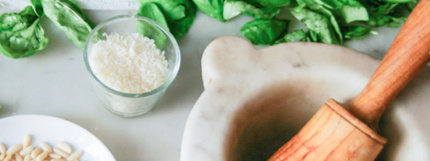There’s so many ways to use this versatile ingredient and more than just the traditional variety to enjoy, whether is tossed through pasta, spread over grilled meat and vegetables, or simply slathered onto good toasted bread.
Pesto, it’s yet another of those Italian culinary inspirations that goes way beyond the sum of it’s parts – a simple (yet brilliant) aromatic concoction of vivid green, the discussion of which can instigate almost religious fervour in its devotees.
The most ardent of these are natives of Liguria, he northern Italian region where pesto was first conceived. The word itself comes from the verb pestare, which meaning to step on, or to pound – preferably in a traditional marble pestle and mortar. The Ligurians are rightly proud of their pesto, a sauce originally created by the peasants from the least expensive and most easily available ingredients. While the nobles of nearby Bolognia feasted on their rich, meaty ragus, the workers of Liguria stirred a few spoons of pesto through a dish of homemade pasta.
This pesto, the product of just six ingredients; fresh basil, pine nuts and hard cheese (most usually parmesan), pounded together with olive oil, garlic and salt, is the one that has journeyed to supermarket shelves around the world in recent decades, so it’s worth remembering that this sauce’s full name is actually Pesto Genovese, and it is only one of a host of mouth-watering pesto variations, all of which are certain to bring a blossoming flavour spring to any menu.
Below are some other traditional and contemporary pestos, ready to inspire.
PESTO DI RUCOLA (ROCKET PESTO)
Made using arugula (rocket) leaves rather than basil, and with the addition of lemon zest, for a zingy, peppery pesto that’s often paired with steamed artichokes or fish.
COMBINE:
2 cups packed arugula (rocket) leaves
1 cup extra-virgin olive oil 1⁄2 cup finely grated Pecorino
1⁄2 cup finely grated Parmesan
1⁄3 cup pine nuts
1 tbsp. lemon zest
1 clove garlic, chopped
Sea salt and freshly ground black pepper, to taste
PESTO CALABRESE
This spicy, southern Italian-style pesto uses a modest quantity of ricotta to tempers the flavour of red pepper, making a mildly spicy, creamy orange pesto that's excellent spread on bruschetta.
COMBINE
1 small eggplant, peeled and cut into half-inch cubes (cooked until soft)
2 tsp. kosher salt, plus more to taste
1⁄4 cup olive oil 1 red bell pepper, stemmed, seeded, and minced (cooked until soft)
1⁄2 small yellow onion, minced (cooked until soft)
2 plum tomatoes, cored and minced (cooked until soft)
1⁄2 cup ricotta cheese
1⁄3 cup packed basil
Freshly ground black pepper, to taste
PESTO DI NOCE (WALNUT PESTO)
Walnuts have been a popular ingredient for sauces since the Roman times, and this walnut pesto from northern Italy delivers the big, earthy flavour you’d expect.
COMBINE
11⁄2 cups packed basil
1⁄2 cup olive oil
1⁄3 cup toasted walnuts
1⁄4 cup finely grated Pecorino
1⁄4 cup finely grated Parmesan
2 sun-dried tomatoes in oil, finely chopped
2 cloves garlic
Sea salt and freshly ground black pepper, to taste
PESTO ROSSO (SUN-DRIED TOMATO PESTO)
This pesto, thickened with almonds (much like the classic Romanesco sauce from Spain) gets its intense red hue from sun dried tomatoes and Aleppo pepper, as well as sweetness and heat. Perfect with pasta.
COMBINE
1 cup extra-virgin olive oil
1⁄2 cup toasted blanched almonds, chopped
2 tbsp. rosemary leaves, minced
2 tsp. balsamic vinegar
2 tsp. sugar 1⁄2 tsp. Aleppo pepper or paprika
20 pitted oil-cured black olives 1
0 sun-dried tomatoes in oil, chopped 4 cloves garlic, chopped
Sea salt and freshly ground black pepper, to taste
TOP TIP For a superior handmade version of the classic Pesto Genovese, first lightly blanch the fresh basil leaves then plunge them into iced water. This will enhance both the flavour and the pesto’s vibrant green hue.
